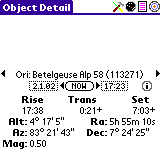

Object Detail
Whenever you select an object in the Catalog, Solar System, or Sky Map form you get a Detail form showing more information for this object.
The displayed information depends on the selected object. For some objects you can even get more information with the up/down arrows. The possible fields are:
- Rise, Trans, Set
- The local time when the object is rising, transiting, or setting.
These times are chosen that they show the transit nearest to the
currently selected time. So if you choose a time late in the evening
it is normal that all times are on the morning of the following
day.
A '+' or '-' sign denotes the following or preceding day, a small circle denotes daylight savings time. When the object is circum polar 'CirPl' is displayed, when it is never above horizon 'NvrUp'. - RA, Dec
- The Right Ascension an Declination fields show the current position of the object in celestial coordinates.
- Alt, Az
- Altitude and Azimuth fields show current position of the moon in local coordinates. An Azimuth of 0 degrees means North.
- IllF
- The percentage of the moon or planet that is illuminated.
- Age
- How far along the moon is in the current cycle. When the age is 0%, a new lunar cycle has begun. The moon is full when it's age is 50%.
- Magnitude
- The brightness of the object in visual magnitude. The magnitude is scaled logarithmically, a magnitude below 0 is very bright, a magnitudes above 4 are visible with the naked eye only in a clear night.
- Phase
- The phase angle is the angle Sun-Planet-Earth.
- Size
- The visual size of an objects in minutes
- Dist
- The distance of a planets in astronomical units (AU). One AU is the mean distance Earth-Sun.
(Note that all information is in the context of the currently selected location, date and time. See the Options panel for information on setting this information.)


Last updated on Fri Oct 04, 2002. Copyright 2001-2002, The AstroInfo SourceForge Project. All trademarks on this page are trademarks of their respective owners. These web pages were created with htp.